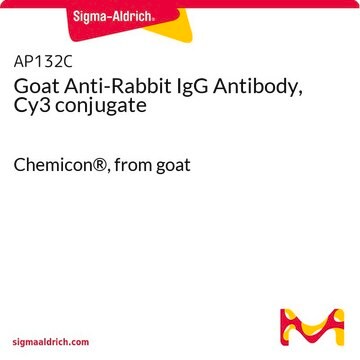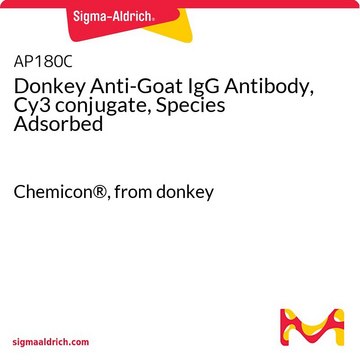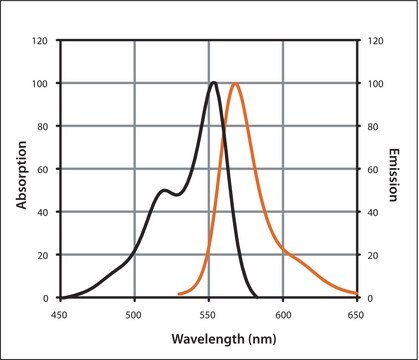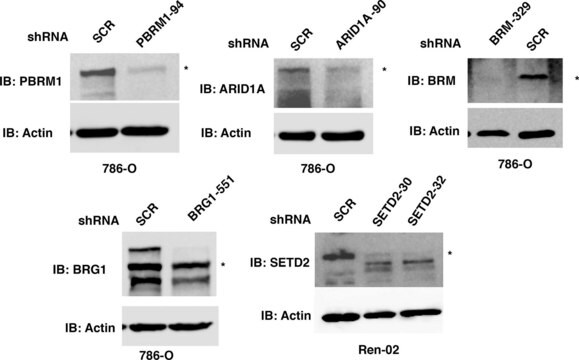AP106C
Rabbit Anti-Goat IgG Antibody, Cy3 conjugate
Chemicon®, from rabbit
Sign Into View Organizational & Contract Pricing
All Photos(1)
About This Item
UNSPSC Code:
12352203
eCl@ss:
32160702
NACRES:
NA.46
Recommended Products
biological source
rabbit
Quality Level
conjugate
CY3 conjugate
antibody form
F(ab′)2 fragment of affinity isolated antibody
antibody product type
secondary antibodies
clone
polyclonal
species reactivity
goat
manufacturer/tradename
Chemicon®
technique(s)
immunofluorescence: suitable
shipped in
wet ice
target post-translational modification
unmodified
Application
Research Category
Secondary & Control Antibodies
Secondary & Control Antibodies
Research Sub Category
Whole Immunoglobulin Secondary Antibodies
Whole Immunoglobulin Secondary Antibodies
This Rabbit anti-Goat IgG Antibody, Cy3 conjugate is validated for use in IF for the detection of Goat IgG.
Legal Information
CHEMICON is a registered trademark of Merck KGaA, Darmstadt, Germany
Disclaimer
Unless otherwise stated in our catalog or other company documentation accompanying the product(s), our products are intended for research use only and are not to be used for any other purpose, which includes but is not limited to, unauthorized commercial uses, in vitro diagnostic uses, ex vivo or in vivo therapeutic uses or any type of consumption or application to humans or animals.
Not finding the right product?
Try our Product Selector Tool.
Signal Word
Warning
Hazard Statements
Precautionary Statements
Hazard Classifications
Aquatic Chronic 3 - Eye Irrit. 2 - Skin Irrit. 2
Storage Class Code
11 - Combustible Solids
WGK
WGK 3
Certificates of Analysis (COA)
Search for Certificates of Analysis (COA) by entering the products Lot/Batch Number. Lot and Batch Numbers can be found on a product’s label following the words ‘Lot’ or ‘Batch’.
Already Own This Product?
Find documentation for the products that you have recently purchased in the Document Library.
Daniela Planska et al.
Anticancer research, 38(8), 4629-4636 (2018-08-01)
Melanoma is a cancer disease with increasing incidence in the Caucasian population. It is often accompanied by spontaneous regression (SR), probably due to high immunogenicity. Understanding of this phenomenon could allow its induction in clinical practice, but detailed study in
Yiyu Deng et al.
PloS one, 9(1), e87420-e87420 (2014-02-06)
Hypoxic exposure in the perinatal period causes periventricular white matter damage (PWMD), a condition associated with myelination abnormalities. Under hypoxic conditions, glial cells were activated and released a large number of inflammatory mediators in the PWM in neonatal brain, which
Vivian W Tang
Biology direct, 1, 37-37 (2006-12-13)
Zonula occludens, also known as the tight junction, is a specialized cell-cell interaction characterized by membrane "kisses" between epithelial cells. A cytoplasmic plaque of approximately 100 nm corresponding to a meshwork of densely packed proteins underlies the tight junction membrane
Avtar S Meena et al.
Cell reports, 39(11), 110937-110937 (2022-06-16)
Intestinal epithelial tight junction disruption is a primary contributing factor in alcohol-associated endotoxemia, systemic inflammation, and multiple organ damage. Ethanol and acetaldehyde disrupt tight junctions by elevating intracellular Ca2+. Here we identify TRPV6, a Ca2+-permeable channel, as responsible for alcohol-induced
Our team of scientists has experience in all areas of research including Life Science, Material Science, Chemical Synthesis, Chromatography, Analytical and many others.
Contact Technical Service









